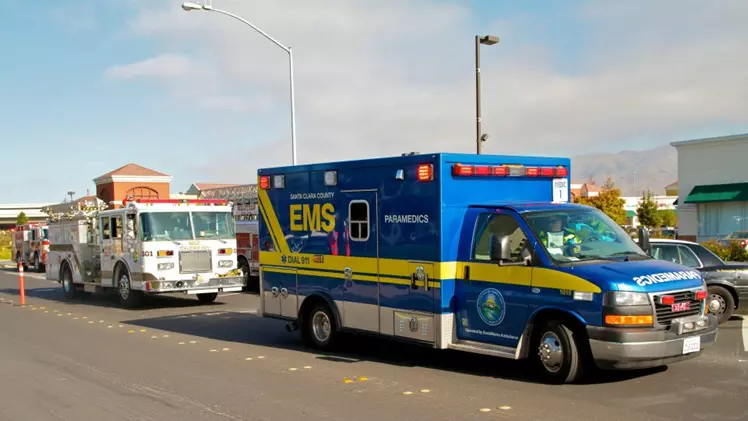‘Deeply Concerning’: Board of Supervisors to Hear Report on Impact of Cuts at Regional Medical Center
The main emergency hospital for East San José announced it will end trauma and cardiac operations, downgrade stroke center

SANTA CLARA COUNTY, Calif. – The County of Santa Clara Board of Supervisors on Tuesday will hear a report detailing the anticipated negative effects of service reductions at Regional Medical Center (RMC) – the main emergency facility serving East San José.
In February, RMC announced that it would cease its trauma and cardiac catheterization programs and downgrade its Comprehensive Stroke Center, effective August 12 of this year. It currently sees about 2,450 trauma patients each year, about a quarter of all trauma cases in Santa Clara County. Trauma patients are those with critical needs surpassing what can be provided at a standard emergency department, for example those with severe car crash injuries, gunshot or stab wounds, major burns or brain injuries.
Downgrading the stroke center from a “comprehensive” to a “primary” designation means procedures for complex stroke cases will no longer be available at RMC. It is currently the only Comprehensive Stroke Center serving the northeast, east and southeast portions of the county, serving about 20% of stroke cases and 65% of stroke cases involving an uninsured patient.
The closure of the cardiac center specializing in catheter services will affect approximately 600 patients each year, who will need to be sent to another facility after their initial diagnosis.
Dr. Kenneth Miller, director of the County’s Emergency Medical Services Agency – which is presenting the report on Tuesday – said 911 transport times and ambulance services would be impacted.
“With the next nearest trauma center about 15 minutes away, there’s no doubt that transport times will increase for those who would presently be best served by RMC,” Dr. Miller said. “Longer transport times also mean ambulances will be less available, and there will be increased need for transport between care centers when a patient’s needs cannot be met at RMC.”
“The golden hour of trauma represents a window of opportunity for hemorrhage control, stabilization, early diagnosis and surgical intervention,” he said. “Lack of timely access to trauma care is associated with poor outcomes and increased mortality, and the people of our community deserve better.”
Supervisor Cindy Chavez, who represents District 2 that includes RMC and the surrounding area, called the cuts a public safety issue.
“The result in delayed access to essential trauma services could lead to longer transport times, delayed care, and potentially increased death rates,” she said. “This closure would have a disproportionate effect on underserved communities of color and increase existing healthcare disparities in low-income communities in East San José.”
Three central themes about the pending closures and service reductions emerged at a March 27 public hearing:

- Patient safety and outcomes: Delayed access to essential services, longer ambulance transport times, potentially increased morbidity and mortality rates.
- Cascading effect on the healthcare system: Increased demand for transfers, ambulance services, and specialty care at other facilities – which will be subject to increased capacity and strain, possibly compromising quality of care.
- Disproportionate effect on vulnerable communities: Existing healthcare disparities would potentially be increased, with a disproportionate impact on communities of color and lower-income communities in East San José.
Paul E. Lorenz, CEO of Santa Clara Valley Healthcare, said County hospitals will bear the brunt of the impact and need to respond to the closures.
“Clearly, we will have to make significant adjustments to take on the additional volume, as it will further impact our already over-burdened physicians, staff, and facilities at both Valley Medical and O’Connor Hospital,” Lorenz said. “We are concerned, but we are determined to do everything possible to support the community and make sure they receive the services they deserve and have a right to expect.”
RMC is owned and operated by Hospital Corporation of America, the largest for-profit public hospital corporation in the United States and one of the largest corporations by revenue in the nation. The latest cuts follow the closure of maternity services at the hospital in 2020, and the recent closure of inpatient psychiatric care at its sister hospital, Good Samaritan.
“This is a highly profitable for-profit business that is shifting its responsibility to the County, which then becomes a burden on taxpayers,” said County Executive James R. Williams. “Regional Medical Center operates the second busiest emergency room in Santa Clara County. Unfortunately, they’re owned by a Tennessee-based corporation that is focused on profits – at the direct expense of people from underserved communities.”
The report is scheduled to be heard by the Board of Supervisors at 2 p.m. Tuesday, April 16, in the Board Chambers at 70 W. Hedding St., San José. Supplemental information and directions on how to participate remotely are available at https://santaclaracounty.primegov.com/public/portal.
ABOUT THE COUNTY OF SANTA CLARA, CALIFORNIA
The County of Santa Clara government serves a diverse, multicultural population of 1.9 million residents in Santa Clara County, Calif., making it more populous than 14 states in the United States. The County provides essential services to its residents, including public health protection, environmental stewardship, medical services through the County of Santa Clara Health System, child and adult protection services, homelessness prevention and solutions, roads, park services, libraries, emergency response to disasters, protection of minority communities and those under threat, access to a fair criminal justice system, and many other public benefits.
Visit the County of Santa Clara at: santaclaracounty.gov
Like us on Facebook: Facebook.com/County.of.Santa.Clara
Follow us on Twitter: Twitter.com/sccgov